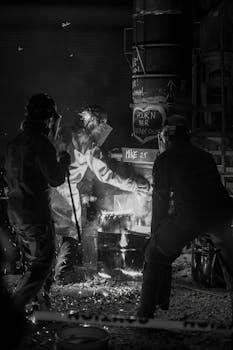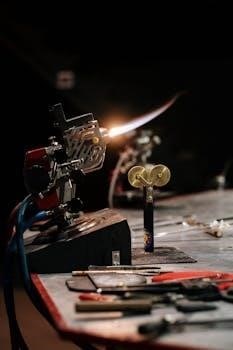Sterling Unit Heater Manual⁚ A Comprehensive Guide
This comprehensive guide offers essential information for Sterling unit heater owners and technicians. It encompasses crucial aspects, from installation to troubleshooting, ensuring efficient and safe operation. Accessing the correct manual is critical for optimal performance.
Sterling HVAC has established itself as a leading name in the heating, ventilation, and air conditioning industry. As a subsidiary of Mestek, Inc., encompassing over 36 HVAC manufacturers, Sterling boasts a rich history spanning over 50 years. The company is known for producing dependable and long-lasting heating equipment suitable for various applications, ranging from residential to commercial and industrial settings.
Their Farmville, North Carolina plant is the heart of their durable gas-fired and oil-fired unit heater production. Sterling HVAC offers solutions for every need, from traditional unit heaters to rooftop and indoor make-up air units. This introduction aims to familiarize users with the Sterling HVAC brand and its commitment to providing high-efficiency heating products. Understanding the company’s background provides context for appreciating the quality and reliability of their unit heaters.
Sterling’s Reputation and History
With over half a century of experience, Sterling HVAC has cultivated a strong reputation for producing high-efficiency heating products. As a division of Mestek, Inc., a collective of over 36 HVAC manufacturers, Sterling benefits from extensive resources and expertise. This long-standing presence in the industry has allowed Sterling to refine its designs and manufacturing processes.
The company is recognized for its commitment to creating durable and dependable heating solutions for diverse applications, including residential, commercial, and industrial needs. Sterling’s history is marked by continuous innovation and a dedication to meeting the evolving demands of the HVAC market. Their reputation is built on a foundation of quality, reliability, and customer satisfaction, making them a trusted name in the heating industry. Their Farmville, North Carolina plant is the heart of their durable gas-fired and oil-fired unit heater production.

Understanding Sterling Unit Heaters
Sterling unit heaters offer efficient heating solutions for various applications. Understanding their types, features, and operational principles is crucial for proper selection, installation, and maintenance, ensuring optimal performance and longevity.
Types of Sterling Unit Heaters⁚ XF and XC Series
Sterling offers the XF (propeller) and XC (blower) series, convertible venting type tubular gas-fired unit heaters. These models provide highly efficient and durable alternatives to traditional designs. The XF series utilizes a propeller for air circulation, ideal for open areas needing direct heat. Conversely, the XC series employs a blower, suitable for spaces requiring more controlled and directed airflow. Both series incorporate advanced tubular heat exchangers and in-shot burners for optimal performance. These units are designed for easy installation and maintenance. Selecting the appropriate series depends on the specific heating requirements of the environment.
Gas-Fired Unit Heaters
Sterling gas-fired unit heaters are designed for efficiency and durability, catering to diverse residential, commercial, and industrial applications. These heaters, often fueled by natural gas or LP, offer reliable heating solutions. Models like the GG series are suitable for garages and outbuildings, providing quiet, thermostat-controlled warmth. Sterling unit heaters feature tubular heat exchangers and direct spark ignition for optimal performance and safety. Regular maintenance, including gas connection and leak testing by qualified professionals, is crucial for safe operation. Converting a unit from natural gas to LP requires specific procedures. Always consult the manual for detailed instructions and safety guidelines.

Manuals and User Guides
This section provides access to essential Sterling unit heater manuals and user guides. These resources contain critical information for installation, operation, maintenance, and troubleshooting, ensuring the longevity and efficiency of your equipment.
Availability of Manuals for Different Models (GG-45, TF-250)
Finding the correct manual for your specific Sterling unit heater model is crucial for proper installation and maintenance. Manuals are readily available for various models, including the GG-45 gas garage heater and the TF-250 unit heater, both tubular gas-fired direct spark propeller unit heaters. These manuals often contain detailed installation instructions and parts lists.
Specifically, the GG-45 manual provides troubleshooting guides. Accessing these resources allows users to address common issues like flame pop-back or noisy flames effectively. These documents provide valuable information to ensure safe and efficient operation for both residential and commercial applications. Referencing your model-specific manual is always the first step in resolving any issues.
Importance of Reading the Manual Before Installation and Operation
Before installing or operating any Sterling unit heater, thoroughly reading the associated manual is paramount for ensuring safety and optimal performance. These manuals contain critical information regarding proper installation procedures, gas connection guidelines, and electrical requirements that prevent dangerous situations. The manual also outlines correct operational steps, troubleshooting tips, and maintenance schedules, extending the unit’s lifespan.
Ignoring these instructions could lead to improper installation. Improper use may void warranties. Safety hazards include gas leaks or electrical shorts. Taking the time to understand the manual ensures safe and efficient operation. It also maximizes the heater’s longevity while minimizing potential problems. Always consult the manual first.

Installation Instructions
Proper installation is critical for safe and efficient operation. Consult the manual for specific model instructions. Ensure correct gas and electrical connections. Follow all local codes and regulations carefully.
General Installation Guidelines
Before commencing installation, carefully review the unit’s manual and all accompanying documentation. Verify that the selected location complies with the heater’s clearance requirements, ensuring sufficient space for airflow and maintenance. Securely mount the unit using appropriate hardware, adhering to weight and vibration considerations. Double-check all gas and electrical connections, engaging qualified technicians where necessary, and consult the manual. Ensure proper venting to prevent the accumulation of harmful gases, consulting local codes for compliance. Prioritize safety by installing a readily accessible disconnect switch. Before initial startup, meticulously inspect all components, consulting the manual, and address any concerns. Following these guidelines will promote optimal performance and safety. Consult the manual for model-specific directions.
Gas Connection and Leak Testing
Gas connections must be performed by qualified professionals, adhering to local codes and regulations. Prior to connecting the gas supply, ensure the gas line is properly sized for the unit’s BTU input. Apply pipe joint compound sparingly to threaded connections, avoiding excess that could contaminate gas lines. After completing connections, perform a thorough leak test using a non-corrosive leak detection solution. Check all fittings, including those at the gas valve and manifold. Never use an open flame to detect leaks. If any leaks are detected, immediately shut off the gas supply, tighten the connection, and retest. Consult the unit’s manual for specific pressure testing procedures and recommended gas types. Following these steps ensures a safe and reliable gas connection. Always double-check your work against the manual’s guidance for the intended model.

Troubleshooting Guide
This section addresses common issues encountered with Sterling unit heaters. It provides diagnostic steps and solutions for efficient repairs. Always consult the manual before attempting any troubleshooting procedures for safety.
Common Problems and Solutions
Addressing common issues is crucial for maintaining optimal performance. One frequent problem involves the flame popping back, often caused by an incorrect burner orifice or low manifold pressure. Noisy flames can stem from irregular orifices creating whistling or resonance. A unit failing to ignite despite a lit pilot might indicate a malfunctioning gas valve or a blocked pilot tube.
Ensure proper gas connections and conduct leak tests as outlined in the manual. Always verify the unit is set to burn the correct fuel type, either natural gas or LP, with appropriate conversions performed by qualified personnel if needed. Regular maintenance and prompt attention to these common problems will extend the lifespan and efficiency of your Sterling unit heater.
Troubleshooting Noisy Flame and Flame Pop-Back Issues
Addressing a noisy flame or flame pop-back requires careful diagnosis. A noisy flame often indicates an irregular burner orifice, causing a whistling sound or resonance within the unit. Inspect the orifice for any obstructions or damage, and clean or replace it as needed. Flame pop-back, where the flame momentarily extinguishes and then reignites with a “pop,” can result from several factors.
Check for an incorrect burner orifice size or low manifold pressure. Verify that the gas supply pressure is within the specified range. Ensure proper venting to prevent backdrafts, which can disrupt the flame. Consult your Sterling unit heater manual for detailed troubleshooting steps and safety precautions before attempting any repairs.
Maintenance and Parts
Regular maintenance is crucial for longevity. Identifying and ordering replacement parts promptly ensures continued efficient operation. Consult your manual for part numbers and recommended maintenance schedules and procedures.
Importance of Regular Maintenance
Regular maintenance of your Sterling unit heater is paramount for ensuring its longevity, efficiency, and safe operation. Neglecting routine checks and servicing can lead to a multitude of problems, including decreased heating performance, increased energy consumption, and potential safety hazards. A well-maintained unit operates at its peak efficiency, providing consistent and reliable heating while minimizing energy waste.
Furthermore, regular maintenance helps identify potential issues early on, preventing costly repairs and downtime. Simple tasks such as cleaning the unit, inspecting the burners, and checking gas connections can significantly extend the lifespan of your heater. Adhering to the manufacturer’s recommended maintenance schedule, as outlined in the manual, is essential for optimal performance and safety. Prioritizing maintenance ensures a comfortable and safe environment.
Identifying and Ordering Replacement Parts
When your Sterling unit heater requires replacement parts, accurate identification is crucial for ensuring compatibility and proper function. Begin by consulting your unit’s manual, which contains detailed parts diagrams and lists. These resources provide specific part numbers and descriptions, facilitating accurate ordering. Note the model and serial number of your unit, as this information is essential for identifying the correct components.
Contact an authorized Sterling HVAC dealer or supplier to place your order. Providing them with the part number, model, and serial number will help them verify the correct part and ensure a timely delivery. Using genuine Sterling replacement parts is recommended, as they are designed to meet the unit’s specific requirements and maintain its performance and safety standards. Avoid using generic parts, as they may compromise the unit’s efficiency and lifespan.
